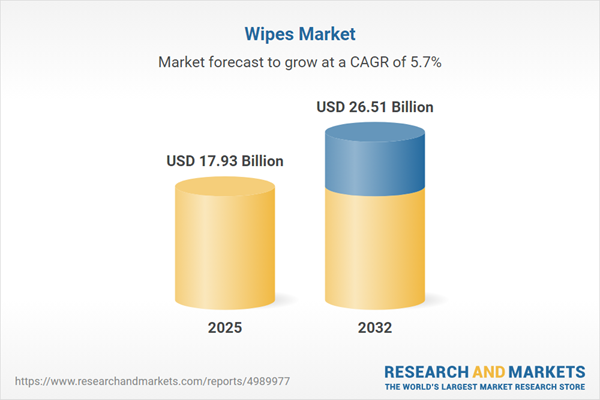Speak directly to the analyst to clarify any post sales queries you may have.
The wipes market is undergoing significant change as regulatory updates, sustainability priorities, and digital procurement solutions reshape operational strategies globally. Senior leaders must anticipate these shifts to preserve competitiveness and direct organizational growth.
Market Snapshot: Wipes Market Overview & Growth
The global wipes market is valued at USD 16.97 billion in 2024 with projections indicating steady expansion to USD 17.93 billion in 2025 and USD 26.51 billion by 2032, reflecting a CAGR of 5.73%. Enhanced hygiene standards, strong demand for innovative product features, and advancements in packaging are key elements supporting this growth. Sector momentum is increasingly influenced by evolving regulator expectations and shifting regional market dynamics. Senior decision-makers are optimizing compliance frameworks and adapting strategic approaches to position their organizations for sustained operational resilience and future market leadership.
Scope & Segmentation of the Global Wipes Market
Targeted segmentation in the wipes market enables executive teams to efficiently allocate resources toward innovation, risk management, and procurement aligned with both current industry expectations and emerging trends across established and new geographies.
- Product Types: Baby wipes, disinfecting wipes, household cleaning wipes, and industrial wipes address requirements in personal care, facility maintenance, and industrial workplaces.
- Baby Wipes: Natural, scented, and unscented offerings address skin sensitivities and hypoallergenic needs for infants and adults alike.
- Disinfecting Wipes: Alcohol, bleach, and quaternary ammonium varieties meet infection control criteria in medical, institutional, and workplace environments.
- Household Wipes: Floor, glass, and multisurface products serve residences and small businesses with a focus on cleaning effectiveness and convenience.
- Industrial Wipes: General-purpose and heavy-duty versions boost productivity and facilitate compliance in manufacturing, automotive, and high-traffic facility management.
- End Use: Healthcare, industrial, residential, and both infant and adult personal care applications address a broad spectrum of hygiene challenges.
- Distribution Channel: Retail, pharmacies, supermarkets, and digital procurement platforms provide multiple access points, supporting evolving purchasing preferences.
- Packaging Type: Canisters, packets, flip-top boxes, jars, refill pouches, and travel packs address portability, use case specificity, and recycling needs.
- Regions Covered: Americas, Europe, Middle East, Africa, and Asia-Pacific, including in-depth market coverage on China, India, Japan, Australia, and Southeast Asia for local procurement and entry strategies.
- Observed Companies: Leading suppliers such as Kimberly-Clark, Procter & Gamble, Essity, Unilever, Johnson & Johnson, Medline Industries, Reckitt Benckiser, Clorox, Ontex, and Georgia-Pacific are featured in the analysis.
Key Takeaways for Senior Decision-Makers
- Sustainability priorities are accelerating adoption of compostable and recyclable materials, prompting integration of circular economy models in procurement and production planning.
- Rapidly evolving regulations require companies to frequently revise product formulations and packaging, making proactive compliance monitoring critical for risk minimization and supplier management.
- Digital procurement and enhanced supply chain visibility empower suppliers to interact directly with buyers, improving transparency, data-driven decision-making, and responsiveness to market demand.
- Growing urban populations and mobile workforces intensify the market need for compact, waterless, and portable wipes, challenging manufacturers to develop flexible solutions for diverse settings.
- Strategic mergers, partnerships, and regional alliances are reinforcing supply chains, enabling efficient resource allocation and improved risk mitigation in cross-border distribution environments.
Tariff Impact and Supply Chain Resilience
With anticipated U.S. tariffs in 2025, wipes sector organizations are pursuing diversified sourcing and nearshoring agendas to manage increased costs and regulatory uncertainty. Adaptive supply chain models and collaborative supplier networks will be essential for maintaining supply consistency and containing procurement risk as tariff and policy shifts redefine the market landscape.
Methodology & Data Sources for the Wipes Market
This assessment draws on thorough secondary research and direct industry interviews, supported by validated forecasting tools and detailed qualitative analysis. The methodology is tailored to supply actionable intelligence for those leading procurement, compliance, and operational risk functions.
Why This Report Matters
- Supports development of strategies that respond to regulatory and market shifts impacting global wipes supply chains and demand profiles.
- Provides detailed segmentation and region-focused analysis for improved market entry, procurement planning, and risk management.
- Equips executives to pursue sustainability and compliance initiatives that align with operational and industry-wide goals.
Conclusion & Strategic Perspective
Proactive innovation, robust supply networks, and diligent compliance management empower organizations to adapt within the evolving wipes market and support sustainable growth trajectories.
Additional Product Information:
- Purchase of this report includes 1 year online access with quarterly updates.
- This report can be updated on request. Please contact our Customer Experience team using the Ask a Question widget on our website.
Table of Contents
3. Executive Summary
4. Market Overview
7. Cumulative Impact of Artificial Intelligence 2025
Companies Mentioned
The companies profiled in this Wipes market report include:- Kimberly-Clark Corporation
- The Procter & Gamble Company
- Essity AB
- Unilever PLC
- Johnson & Johnson
- Medline Industries, LP
- Reckitt Benckiser Group plc
- The Clorox Company
- Ontex Group NV
- Georgia-Pacific LLC
Table Information
| Report Attribute | Details |
|---|---|
| No. of Pages | 195 |
| Published | October 2025 |
| Forecast Period | 2025 - 2032 |
| Estimated Market Value ( USD | $ 17.93 Billion |
| Forecasted Market Value ( USD | $ 26.51 Billion |
| Compound Annual Growth Rate | 5.7% |
| Regions Covered | Global |
| No. of Companies Mentioned | 11 |









